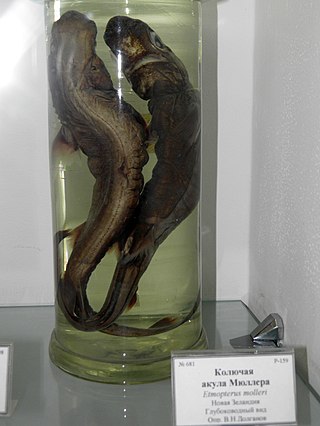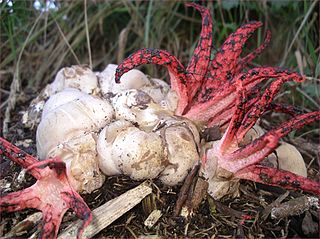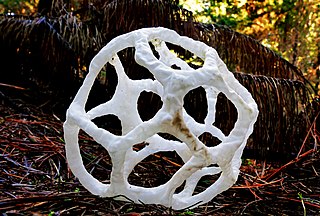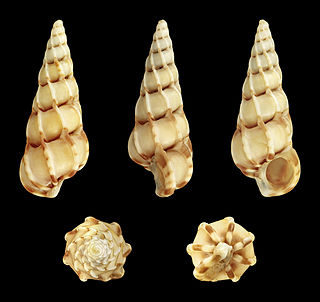
Phallaceae is a family of fungi, commonly known as stinkhorns, within the order Phallales. Stinkhorns have a worldwide distribution, but are especially prevalent in tropical regions. They are known for their foul-smelling, sticky spore masses, or gleba, borne on the end of a stalk called the receptaculum. The characteristic fruiting-body structure, a single, unbranched receptaculum with an externally attached gleba on the upper part, distinguishes the Phallaceae from other families in the Phallales. The spore mass typically smells of carrion or dung, and attracts flies, beetles and other insects to help disperse the spores. Although there is great diversity in body structure shape among the various genera, all species in the Phallaceae begin their development as oval or round structures known as "eggs". The appearance of Phallaceae is often sudden, as gleba can erupt from the underground egg and burst open within an hour. According to a 2008 estimate, the family contains 21 genera and 77 species.

Lorraine Mary Moller is a former athlete from New Zealand, who competed in track athletics and later specialised in the marathon. Moller's international career lasted over 20 years and included winning a silver medal in the marathon at the 1986 Commonwealth Games in Edinburgh and a bronze medal in the marathon at the 1992 Olympic Games in Barcelona at the age of 37. A four-time Olympian, she also completed the marathon at the 1984, 1988 and 1996 games. Her other marathon victories included the 1984 Boston Marathon and being a three-time winner (1986,87,89) of the Osaka International Ladies Marathon.

The slendertail lanternshark or Moller's lanternshark is a shark of the family Etmopteridae found in the western Indian Ocean between latitudes 34°N and 46°S at depths between 250 and 860 m. It can grow up to 46 cm in length.

David Arora is an American mycologist, naturalist, and writer. He is the author of two popular books on mushroom identification, Mushrooms Demystified and All That the Rain Promises and More....

Clathrus is a genus of fungi of the family Phallaceae, the stinkhorn fungi. Mature fruit bodies are covered with olive-brown slimy gleba, containing spores, that attract flies. These fungi are saprobic and are common in mulch.

Clathrus archeri, commonly known as octopus stinkhorn or devil's fingers, is a fungus which has a global distribution. This species was first described in 1980 in a collection from Tasmania. The young fungus erupts from a suberumpent egg by forming into four to seven elongated slender arms initially erect and attached at the top. The arms then unfold to reveal a pinkish-red interior covered with a dark-olive spore-containing gleba. In maturity it smells like putrid flesh. Recently, C. archeri var. alba with white tentacles or arms has been reported from the Shola Forests in the Western Ghats, Kerala, India.

Clathrus ruber is a species of fungus in the family Phallaceae, and the type species of the genus Clathrus. It is commonly known as the latticed stinkhorn, the basket stinkhorn, or the red cage, alluding to the striking fruit bodies that are shaped somewhat like a round or oval hollow sphere with interlaced or latticed branches. The fungus is saprobic, feeding off decaying woody plant material, and is often found alone or in groups in leaf litter on garden soil, grassy places, or on woodchip garden mulches. Although considered primarily a European species, C. ruber has been introduced to other areas, and now has a wide distribution that includes all continents except Antarctica. The species was illustrated in the scientific literature during the 16th century, but was not officially described until 1729.

Ileodictyon is a genus of fungi in the family Phallaceae. Basidiocarps are clathroid, emerging from egg-like peridia and forming spongy "arms" which connect to create a cage-like lattice. The basidiospores on the arms are covered by a foetid slime that attracts flies, the agents of spore dispersal. There are three named species and one currently unnamed. The unnamed species, called "the green cage fungus", is endemic to New Caledonia and is considered globally threatened. It is assessed as "endangered" on The IUCN Red List of Threatened Species.

Pseudocolus fusiformis is a stinkhorn mushroom in the Phallaceae, a family well known for a remarkable range of fruit body types. It is the most widely distributed member of the genus Pseudocolus and has been found in the United States, Australia, Japan, Java, and the Philippines. It is commonly known as the stinky squid, because of its fetid odor, and its three or four upright "arms" which are connected at the top. The malodorous smell comes from the dark greenish slimy gleba covering the inside faces of the arms, and attracts insects that help to disperse the spores.

Pseudocolus is a genus of fungi in the stinkhorn family. The fruit bodies have three or four simple arms that are initially joined at the tip, but often break apart. The tips of the arms are covered with a slimy, foul-smelling gleba, which attracts insects that help disperse the spores. The genus contains three species: the type Pseudocolus fusiformis, P. garciae, similar in appearance to the type but with a pinkish to red, rather than orange color, and P. grandis, found in India.

Clathrus columnatus, commonly known as the column stinkhorn, is a saprobic species of basidiomycete fungus in the family Phallaceae. It has a widespread distribution, and has been found in Africa, Australasia, and the Americas. It may have been introduced to North America with exotic plants. Similar to other stinkhorn fungi, the fruiting body, known as the receptaculum, starts out as a subterranean "egg" form. As the fungus develops, the receptaculum expands and erupts out of the protective volva, ultimately developing into mature structures characterized by two to five long vertical orange or red spongy columns, joined at the apex. The fully grown receptaculum reaches heights of 8 cm (3.1 in) tall. The inside surfaces of the columns are covered with a fetid olive-brown spore-containing slime, which attracts flies and other insects that help disseminate the spores. Although once considered undesirable, the fungus is listed as edible. It is found commonly in mulch.

Epitonium clathrus, also known as the common wentletrap, is a species of small predatory sea snail, a marine gastropod mollusc in the family Epitoniidae, the wentletraps.
Clathrina chrysea is a species of calcareous sponge from New Caledonia. The species epithet refers to the light yellow colour of the sponge.
Ascandra contorta is a species of calcareous sponge belonging to the family Clathrinidae.

Clathrus bicolumnatus is a species of fungus in the stinkhorn family. It is known only from Japan.

Clathrus crispus is a species of fungus in the stinkhorn family. Reported as new to science in 1820, it is found in the Americas.
Clathrus kusanoi is a species of fungus in the stinkhorn family. It is known only from Japan.

Clathrus transvaalensis is a species of fungus in the stinkhorn family. It is found in South Africa. It was described as new to science in 1990 by mycologists Albert Eicker and Derek Reid. The fruit body forms a hollow, pale yellow to pinkish lattice structure.

Bidenichthys is a genus of viviparous brotulas.

Grand Designs New Zealand is a New Zealand television series. It is based on the British television series Grand Designs and it was originally presented by the architect Chris Moller and aired on TV3. It began airing in New Zealand on 4 October 2015.















